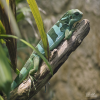Brachylophus bulabula
The Fijian banded iguana is found on the southeastern Fijian islands. In the wild they live between 10 to 15 years while in capivity they can live over 25 years. Fijian banded iguana can reach 60 cm (24 in) in length when measured from snout to tail tip and can weigh up to 200 grams (7 oz). They have a short (0.5 cm) crest. The Fijian banded iguana are sexually dimorphic, the males which are slightly larger, have two or three white or pale-blue bands 2 cm (.79 in) wide crossing their emeraldgreen background with a pattern of spots and stripes on the nuchal region and their tails also may have the bands. The females may have some light spots or partial bands. Their underside and nostrils are colored yellow with red-orange eyes. They are one of the few species of iguana found outside of the New World and one of the most geographically isolated members of the Iguanidae family. It is thought that this iguana was introduced by humans to the Tonga area. Predators of the Fijian banded iguana include rats, mongooses, and cats. The biggest threat to them is the loss of habitat due to fires, storms, agricultural development and competition from feral goats Humans take them for food and for the illegal pet trade.

